Accepted Scientific Name: Rebutia arenacea Cárdenas
Cact. Succ. J. (Los Angeles) 23: 94. 1951

Weingartia arenacea (Rebutia arenacea) Photo by: Diego Armentano
Origin and Habitat: Cochabamba, Bolivia, South America. The species has a very restricted range (area of occupancy <20km2 ) and it is known only from the type locality.
Altitude: 1,500-1,600 metres above sea level.
Habitat and Ecology: Rebutia arenaceaSN|15056]]SN|15056]] grows in seasonally dry inter-Andean valley. The species is naturally scarce and near Threatened because there are no obvious threats affecting it. The plant is use as an ornamental in specialised collections, come from cultivation, not from wild populations.
Synonyms:
See all synonyms of Rebutia arenacea
back
Accepted name in llifle Database:Rebutia arenacea CárdenasCact. Succ. J. (Los Angeles) 23: 94. 1951Synonymy: 26
back
Description: Rebutia arenaceaSN|15059]]SN|15056]], better known as SulcoSN'> 15057' alt='15080'>Rebutia arenacea#SN#15056'>Sulco[[Rebutia arenaceaSN' style='border:none;'>, is a choice solitary user-friendly plant, with perfectly neat, symmetrical pectinate spination and profuse yellowish orange flowers. This cactus is indeed beautiful even without its blooms.
15057' alt='15080'>Rebutia arenacea#SN#15056'>Sulco[[Rebutia arenaceaSN' style='border:none;'>, is a choice solitary user-friendly plant, with perfectly neat, symmetrical pectinate spination and profuse yellowish orange flowers. This cactus is indeed beautiful even without its blooms.
Habit: It is a low-growing geophytic, stem-succulent. The stems can form pups after a certain size and age.
Related species: It is closely allied and intergrades with Rebutia glomerisetaSN|15056]]SN|15080]] and Rebutia candiaeSN|15056]]SN|15059]] that grows in the same area. They may all be different forms of the same polymorphic species.
Stems: Globoid flat to the ground 2-4 cm tall 2,-6 cm in diameter, yellowish/greenish to brownish/purple, with about 30 spiralled and strong tuberculate ribs.
Areoles: Elongate, creamy grey.
Spines: 14-16, Tiny, up to 4(-5) mm long, minutely pubescent whitish yellowish, amber or tan smooth, pectinate held tightly that give a sandy effect.
Flower: Very nice 2,5/3 cm large and long, yellow to yellowish-orange.
Blooming season: Late winter to spring.
Fruits: Reddish brown.
Subspecies, varieties, forms and cultivars of plants belonging to the Rebutia arenacea group
 Rebutia arenacea Cárdenas: (Sulcorebutia arenacea) has 14-16, tiny spines, all radials, up to 4(-5) mm long, minutely pubescent whitish, amber or tan, pectinate held tightly that give a sandy effect. Distribution: Cochabamba.
Rebutia arenacea Cárdenas: (Sulcorebutia arenacea) has 14-16, tiny spines, all radials, up to 4(-5) mm long, minutely pubescent whitish, amber or tan, pectinate held tightly that give a sandy effect. Distribution: Cochabamba. Rebutia candiae Cárdenas: (Sulcorebutia arenacea var. candiae) very similar to S. glomeriseta but spines shorter and pectinate bristly, interlecing creamy yellow to brownish. Distribution: border area of Chochabamba.
Rebutia candiae Cárdenas: (Sulcorebutia arenacea var. candiae) very similar to S. glomeriseta but spines shorter and pectinate bristly, interlecing creamy yellow to brownish. Distribution: border area of Chochabamba. Rebutia glomeriseta Cárdenas: (Sulcorebutia glomeriseta) Spines not easily differentiable from radials and centrals, fine, bristly, interlecing creamy yellow to brownish. Distribution: border area of Bolivia-Paraguay-Argentina.
Rebutia glomeriseta Cárdenas: (Sulcorebutia glomeriseta) Spines not easily differentiable from radials and centrals, fine, bristly, interlecing creamy yellow to brownish. Distribution: border area of Bolivia-Paraguay-Argentina.- Rebutia menesesii Cárdenas: (Sulcorebutia arenacea var. menesesii)
- Sulcorebutia arenacea var. kamiensis (Bredero & Donald) Gertel & J.de Vries
- Sulcorebutia muschii R.Vásquez
Bibliography: Major references and further lectures
1) James Cullen, Sabina G. Knees, H. Suzanne Cubey “The European Garden Flora Flowering Plants: A Manual for the Identification of Plants Cultivated in Europe, Both Out-of-Doors and Under Glass” Cambridge University Press, 11/Aug./2011
2) David Hunt, Nigel Taylor “The New Cactus Lexicon” DH Books, 2006
3) Edward F. Anderson “The Cactus Family” Timber Press, 2001
4) Anderson E. F.: "The Cactus Family" Timber Press, Portland, Oregon, 2001
5) Ritter Fr.: "Kakteen in Südamerika" Spangenberg, 1980
6) John Pilbeam "Sulcorebutia and Weingartia: A Collector's Guide" Timber Press, 1985
7) E Haustein “Der Kosmos Kakteenfuehrer (the Kosmos Cactus Guide)” Balogh Scientific Books 01 December 1998
8) Cullmann W., Götz E., Gröner G.”Kakteen: Kultur, Vermehrung und Pflege - Lexikon der Gattungen und Arten” Ulmer, Stuttgart, 1984
9) Lowry, M. & Carr, J. 2013. Rebutia arenacea. The IUCN Red List of Threatened Species. Version 2014.3. <www.iucnredlist.org>. Downloaded on 27 December 2014.
 Weingartia arenacea (Rebutia arenacea) Photo by: Valentino Vallicelli
Weingartia arenacea (Rebutia arenacea) Photo by: Valentino Vallicelli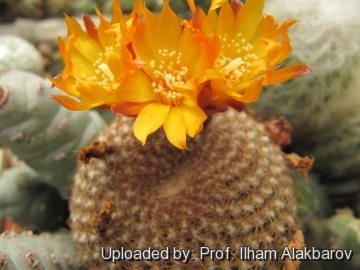 Weingartia arenacea (Rebutia arenacea) Photo by: Prof. Ilham Alakbarov
Weingartia arenacea (Rebutia arenacea) Photo by: Prof. Ilham Alakbarov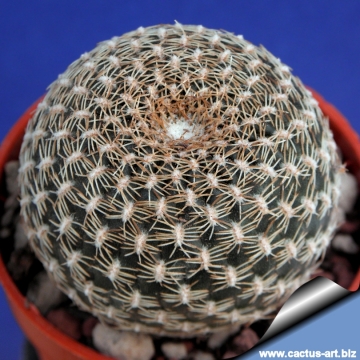 Weingartia arenacea (Rebutia arenacea) Photo by: Cactus Art
Weingartia arenacea (Rebutia arenacea) Photo by: Cactus Art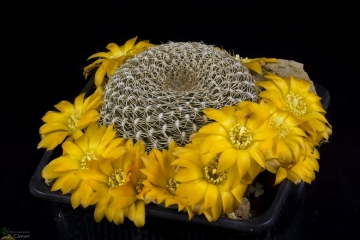 Weingartia arenacea (Rebutia arenacea) Photo by: Peiffer Clement
Weingartia arenacea (Rebutia arenacea) Photo by: Peiffer Clement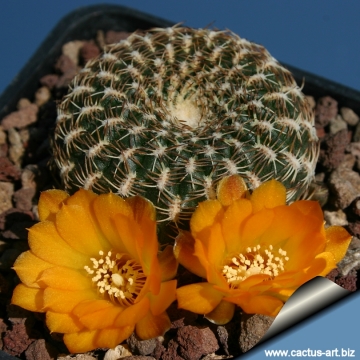 Weingartia arenacea (Rebutia arenacea) Photo by: Cactus Art
Weingartia arenacea (Rebutia arenacea) Photo by: Cactus Art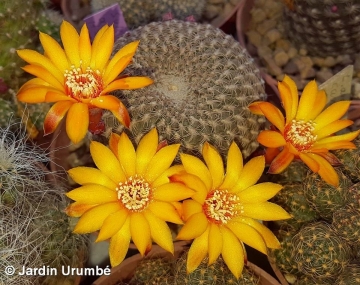 Weingartia arenacea (Rebutia arenacea) Photo by: Alexander Arzberger
Weingartia arenacea (Rebutia arenacea) Photo by: Alexander Arzberger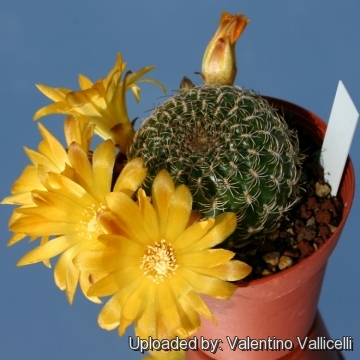 Weingartia arenacea (Rebutia arenacea) Photo by: Valentino Vallicelli
Weingartia arenacea (Rebutia arenacea) Photo by: Valentino Vallicelli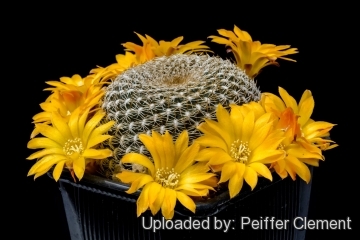 Weingartia arenacea (Rebutia arenacea) Photo by: Peiffer Clement
Weingartia arenacea (Rebutia arenacea) Photo by: Peiffer ClementCultivation and Propagation: These mountainous plants have thick taproots and are susceptible to overwatering. They loves a very permeable, coarse mineral soil as well as to be strictly kept dry throughout the winter quiescent period since it is very sensitive to any moisture excesses, To prevent rottenness it is also advisable to surround its root neck by very rough sand or grit, this help a fast water drainage. They requires also an appropriate air circulation and are sometime grafted to avoid root problems. They need to be kept in a cool place during winter rest (at 0-10°C). This is important for the flowers ,as well as for their health. Without this cool winter period, they normally won't get any buds.
Grafted plants are very easy to grow, and are quite frost hardy (-5° C) if kept dry. Needs a full sun exposure ( light shadow my be useful in the hottest summer days)
Propagation: Seed, cutting, grafting


















